In 1673, a Jesuit missionary, a fur trader, and a small group of canoe men traveled two thousand miles from what is now upper Michigan down to Arkansas and back.
-
November 2020
Volume65Issue7
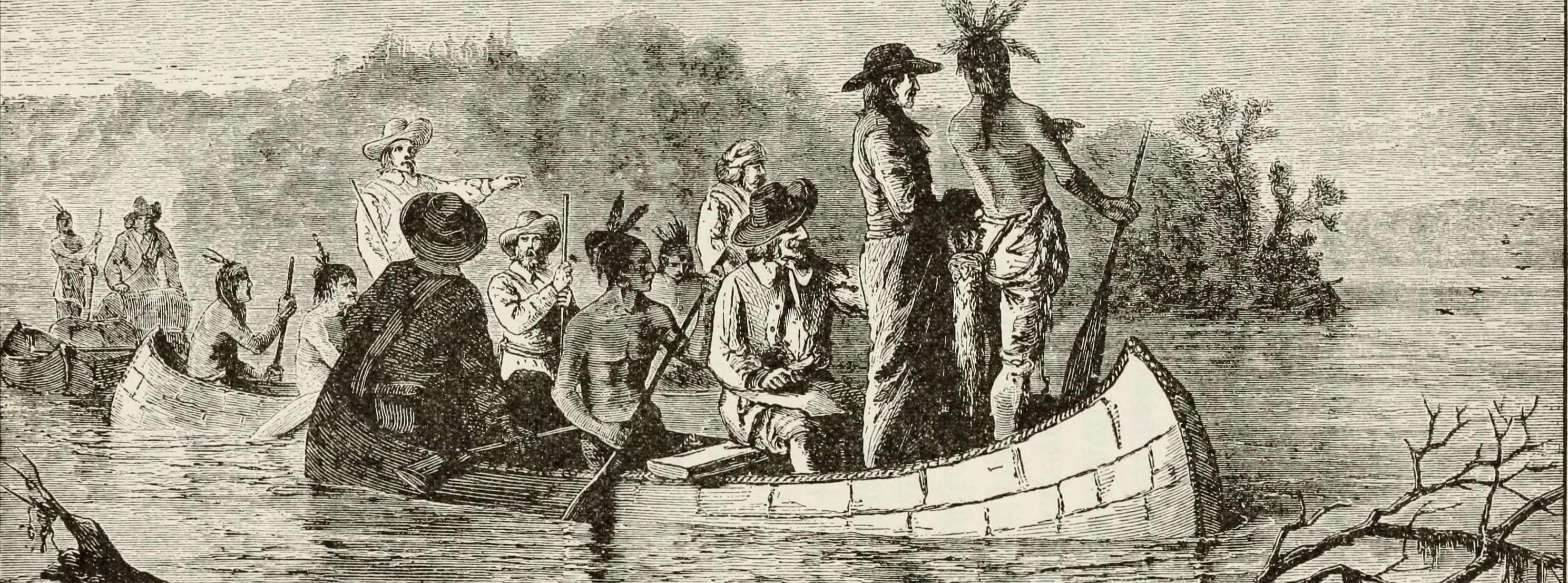
On May 17, 1673 two birch bark canoes carrying seven Frenchmen left the Jesuit mission at Michilimackinac, what is today St. Ignace, Michigan, embarking on what would become one of the greatest voyages of discovery in American history. Their dangerous, two thousand-mile voyage through the interior of North America would take the explorers to learn its geography and to visit its native people.
Leading the expedition were two men whose names are fixtures in the early history of the western Great Lakes states and Mississippi Valley, the Canadian-born fur trader Louis Jolliet and Jesuit missionary Jacques Marquette. Although they were both assigned to the same expedition, the objectives for which they had been tasked were quite different.
See also in this issue: "Upon Starved Rock," by Mark Walczynski,
about a famed landmark visited by Marquette and Jolliet.
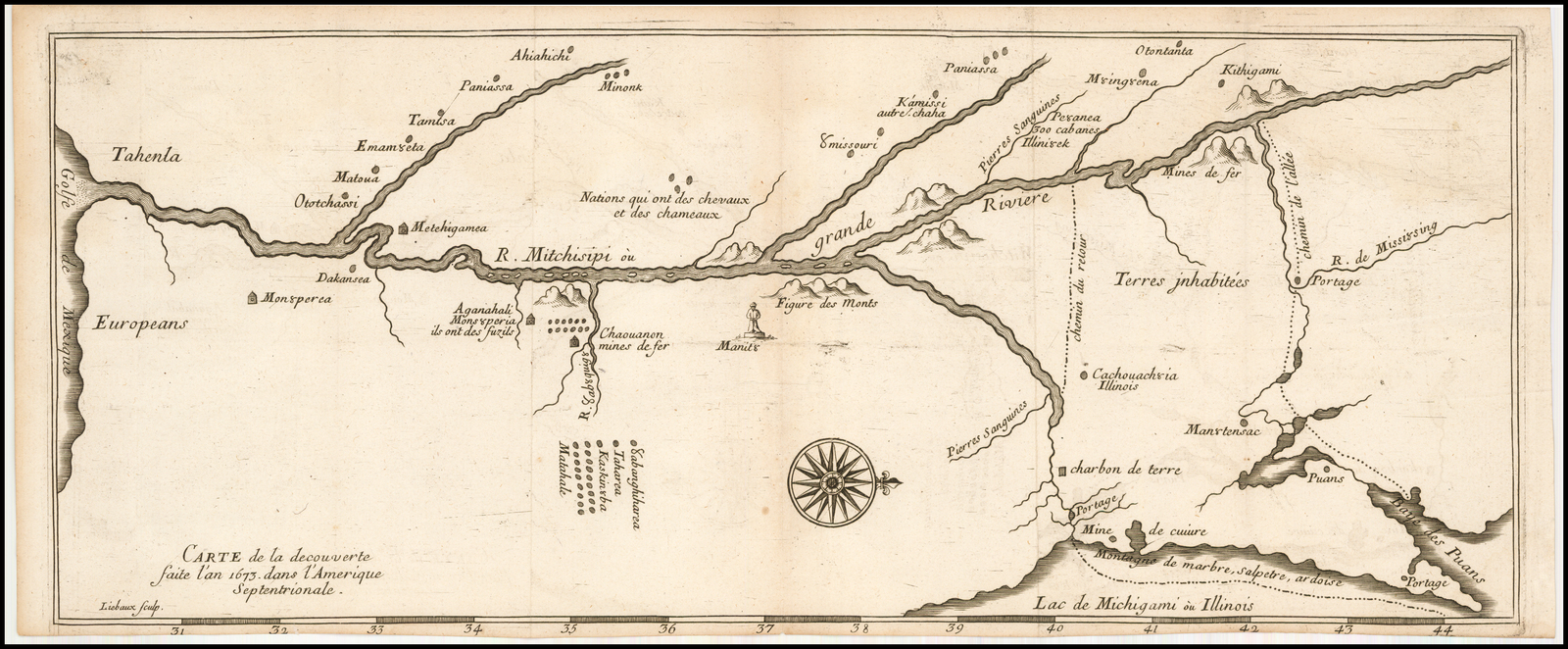
Louis Jolliet was born near Quebec in 1645. Not much is known of his early life. He lost his father when he was five and a step-father four years later. He entered the Jesuit college at Quebec at age eleven, intending to join the priesthood. At the college Jolliet became interested in music, reportedly playing the organ at the Quebec church “for many years.” The 1666 census of Canada lists the future explorer as a clercq d’esglise, a church cleric. Perhaps having second thoughts about the priesthood, Jolliet left the seminary and sailed to France in 1667. He returned to Canada the following year.
Upon his return, Jolliet purchased a large supply of trade goods from his uncle Charles Aubert de La Chesnaye. What Jolliet did with the goods is unknown. It appears that Louis first traveled to the western Great Lakes country during the fall of 1670. Period documents place him at his trading post at Sault Ste. Marie in June 1671. He returned to Lower Canada shortly thereafter.
In contrast, Marquette was born into a notable family of Laon, France. He entered Jesuit school at age 9, eventually earning a bachelor’s and master’s degrees. His education included subjects such as philosophy, which at the time included logic, metaphysics, and mathematics. He also taught at several Jesuit universities. Marquette’s theological training appears to have come later in his academic career. He sailed to Canada in 1666, arriving at Quebec in September. Soon after his arrival he began the study of indigenous languages and customs.
Marquette’s first mission assignment was at Sault Ste. Marie in 1668, teaching and ministering to the Odawa, Ojibwe, and other native groups at their summer villages with fellow Jesuit Claude-Jean Allouez. In September 1669 he began his next field assignment, at the Mission du Saint Esprit, also known as La Pointe, a smattering of approximately twelve tribes who lived in winter camps near Chequamegon Bay, on the south shore of Lake Superior near today’s Ashland, Wisconsin.
At this mission Marquette, like his predecessor Allouez, encountered the Illinois Indians. They left quite an impression on both missionaries who reported that the Illinois were affable, appeared eager for instruction in the Catholic faith, and lived in large, semi-permanent agricultural villages. They also claimed a great river, the Mississippi, traversed their lands. To communicate with the Illinois both missionaries began learning the fundamentals of the Miami-Illinois language. Marquette planned to travel to the Illinois Country in 1671 to visit their villages, meet the Illinois people, and take the first steps in opening a new mission field among the Miami-Illinois speaking tribesmen. However, warfare erupted between the La Pointe tribes and the Sioux forcing the former tribes to scatter. Marquette’s journey to the Illinois Country would be put on hold. He left the Chequamegon area and relocated with his Odawa and Wendat converts at a new mission, St. Ignace at Michilimackinac.
Marquette dutifully ministered to the tribes at his mission when unannounced, Jolliet arrived on December 8, 1672. Jolliet carried orders instructing Marquette to accompany him to the Mississippi and beyond. The two men spent the winter preparing for their journey, pressing the local tribesmen for information about the distant lands and even drawing a rough map based on information gleaned from them. Just before leaving they readied their equipment and prepared food, primarily Indian corn mixed with small bits of meat for the long journey.
Jolliet’s assignment was to “discover new countries” as Marquette wrote. More specifically he was to find out to where the mysterious Mississippi flowed. Did it discharge into the western sea at California, into the Gulf of Mexico, or at Virginia? Another task was to determine if the river known to the Iroquois as Ohio was the same river Algonquian speakers called Mississippi? In addition, Louis was to fund the expedition himself.
Marquette’s role was more nuanced. He would function as a Jesuit scout, a task for which he was well-suited. He was reportedly conversant in several Native American dialects including that of the Miami-Illinois. Marquette also knew cartography. The best evidence indicates that he assisted Allouez to gather information for the now famous 1669 chart titled Lac Tracy ou Superieur avec les dependances de la Mission du Saint Esprit, or map illustrating the dependencies of the Saint Esprit mission. Lac Tracy was the name given to Lake Superior by the French during the 1660s, named for the Lieutenant-General of New France Alexandre de Prouville de Tracy. The missionary planned to seek out Native American villages, record their demographic information, and draw a map that illustrated the location of each village. With these objectives in mind, the crew left Michilimackinac and paddled their canoes to the Mississippi.
The French party skirted the western shore of the Lac des Ilinois, today’s Lake Michigan, and entered the Baie des Puans, present-day Green Bay. The first native group the French encountered was the Folle Avoine, the “Wild Rice People,” also known as the Menominee. Marquette recorded how they harvested, dried, and prepared the grain for consumption. Marquette also noted that the Menominee attempted to dissuade them from continuing their journey, warning the French of many dangers, of tribes who would “break their heads” and of “horrible monsters” who would devour them and their canoes. The missionary thanked the Menominee for their concern but told them that the salvation of souls was more important than their personal safety.
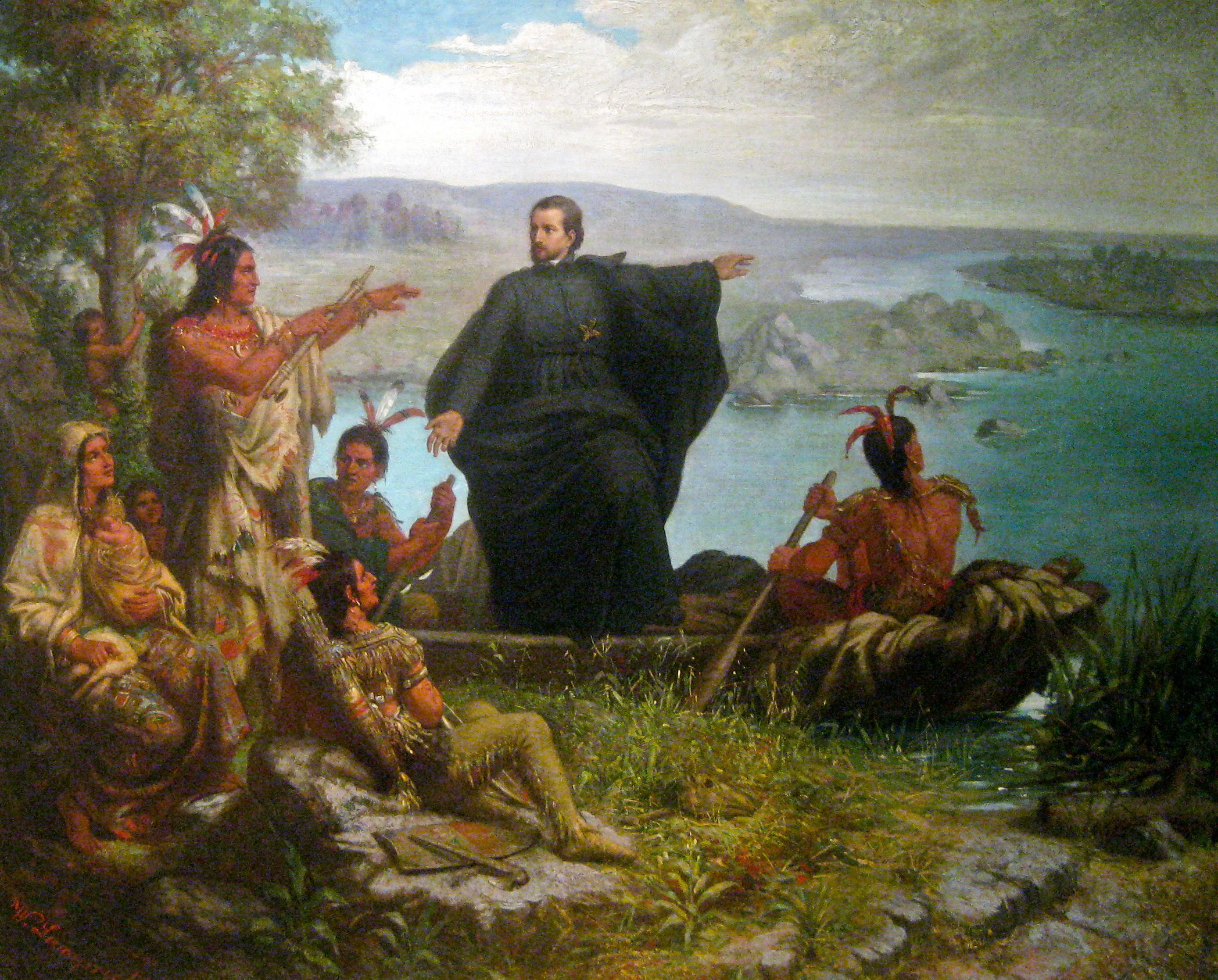
The group continued their journey, entering the Fox River and shortly thereafter encountering the rapids near present-day De Pere, Wisconsin. Likely portaging around the sault, the group continued up the Fox, stopping at a village of Mascouten Indians, also known as the “Fire Nation,” a site that was presumably located near today’s Berlin, Wisconsin. Marquette noted that besides the Mascouten, some Miami and Kickapoo lived at the site. Both Marquette and Jolliet spoke with tribal elders at a council. Besides explaining the reason for their visit the two explorers asked for guides to escort them upriver, to the portage where the French crew hoped to carry their canoes to the Wisconsin River. Although the Mascouten village was not that far from the Wisconsin Portage, the many swamps, lakes, and backwaters that are part of the Fox River drainage could make finding the portage site difficult. Two Miami tribesmen were designated to escort the French upstream.
After reaching the portage, the Miami guides returned to their village, leaving the French group to fend for themselves. Marquette noted that his party had reached a continental divide, where the waters flow south, not east and to the Atlantic. After carrying their canoes and equipment across the 2,700-step portage located at modern-day Portage, Wisconsin, the group paddled their canoes down the Wisconsin River and to the Mississippi. Reaching the Mississippi on June 17, Marquette wrote of the great joy he felt at seeing this grand stream, the highway to the Illinois Country and ultimately the sea.
The French group enjoyed an uneventful journey down the Great River. The missionary noted the various species of wildlife they encountered including bison, deer, and waterfowl, and he described the scenery, the islands, hills, and prairies. Reaching the Des Moines River, the state line between today’s Iowa and Missouri, it appears that the group made a short reconnaissance up the stream. There they saw what appeared to be a path that led through the trees that bordered the river. The party landed their canoes on shore.
Examining the “somewhat beaten path,” as Marquette described it, Jolliet and Marquette cautiously headed up the trail, one that led to a prairie situated on a wide floodplain. After hiking several miles, the two explorers ascended a small rise where they saw three villages in the distance. They slowly approached the first village, not knowing if the inhabitants were friend or foe. So close to it, Marquette wrote, he could hear the inhabitants speaking. Finding themselves in this precarious predicament the two explorers yelled out loud to announce their presence. Hearing their shouts the villagers left their “cabins” and rushed to see who was causing the commotion. What they saw likely surprised them, two Frenchmen, one of whom was wearing a long black gown.
Realizing that Jolliet and Marquette did not pose a threat to the village, four tribal elders came forth to greet the strangers. Marquette soon learned that these people were a band of Peoria, a subtribe of the Illinois alliance. The villages were located at what is now known as the Illiniwek Village State Historical site in Clark County, Missouri.
The two explorers were escorted to the first village where they met the chief who offered them a calumet, a pipe to be smoked in friendship and as a matter of etiquette and hospitality. Soon afterward Jolliet and Marquette were escorted to the second village where they met the “great captain” of the Peoria, who congratulated them for visiting their village. They were next invited to a council of village chiefs and elders where the calumet was smoked and gifts were exchanged. Following the council was a “great feast” that included maize, sagamité, and bison. The Peoria also escorted Jolliet and Marquette through their village, a sizable town consisting of about 300 cabins.
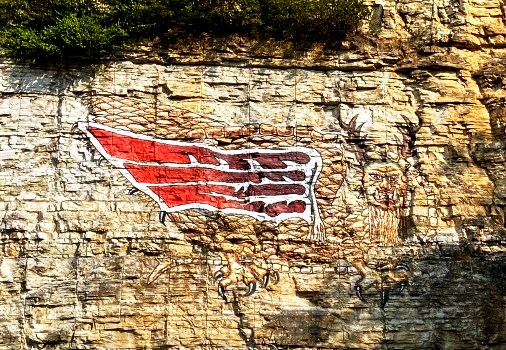
The Frenchmen spent the night with the Illinois. The next afternoon they returned to their canoes followed by a host of admirers. They continued their journey downriver. The party passed two griffon-like images, known today as the Piasa, that were painted on the side of a white limestone cliff near the present-day town of Alton, Illinois. A short distance beyond the Piasa was the mouth of the “Pekistanouï,” the Missouri River, which Marquette noted was flooded, muddy, and carried whole trees in its turbulent waters. 150 miles south of the Missouri the party passed the mouth of the “Ouaboukigou,” the name Marquette applied to today’s Ohio River, which confirmed to them that the Ohio River was not the Mississippi, but a different stream.
The group’s first potential confrontation with hostile tribesmen occurred some distance below the mouth of the Ohio when they saw several armed warriors waiting for the French canoes. The explorers took this as aggression and prepared to defend themselves. Marquette hoped to ease tensions by standing, and raising the calumet high, a sign that they had come in peace. Eventually the two parties figured out that they were misreading each other’s intentions. Neither side wanted violence. The explorers pulled to shore and paid a brief visit to the village. There they received encouraging news, that they were only about ten days journey away from the sea.
The French canoes continued their southbound trek. Near the mouth of Arkansas’ St. Francis River they saw a group of armed warriors paddling toward them who intended to encircle and trap the explorers. Other tribesmen screamed war cries from shore while still others attempted to swim to the French canoes. Again Marquette stood and held the calumet high as a sign of peace but this time the antagonists paid little attention to the priest’s gestures. Fortunately for the French, some village elders saw the calumet Marquette held and called off the attack. With tensions eased, the French paddled to shore and disembarked at the village. The explorers learned that the village belonged to the Michigamea, a tribe that would merge with the Illinois and become a subtribe of the Illinois alliance in the early 18th century. There, they attempted to communicate with the tribesmen, but to no avail. Even though Marquette could speak multiple Native American dialects/languages, his party had traveled beyond the range of his linguistic capabilities. One elderly man at the village, however, could speak a few words of Miami-Illinois.
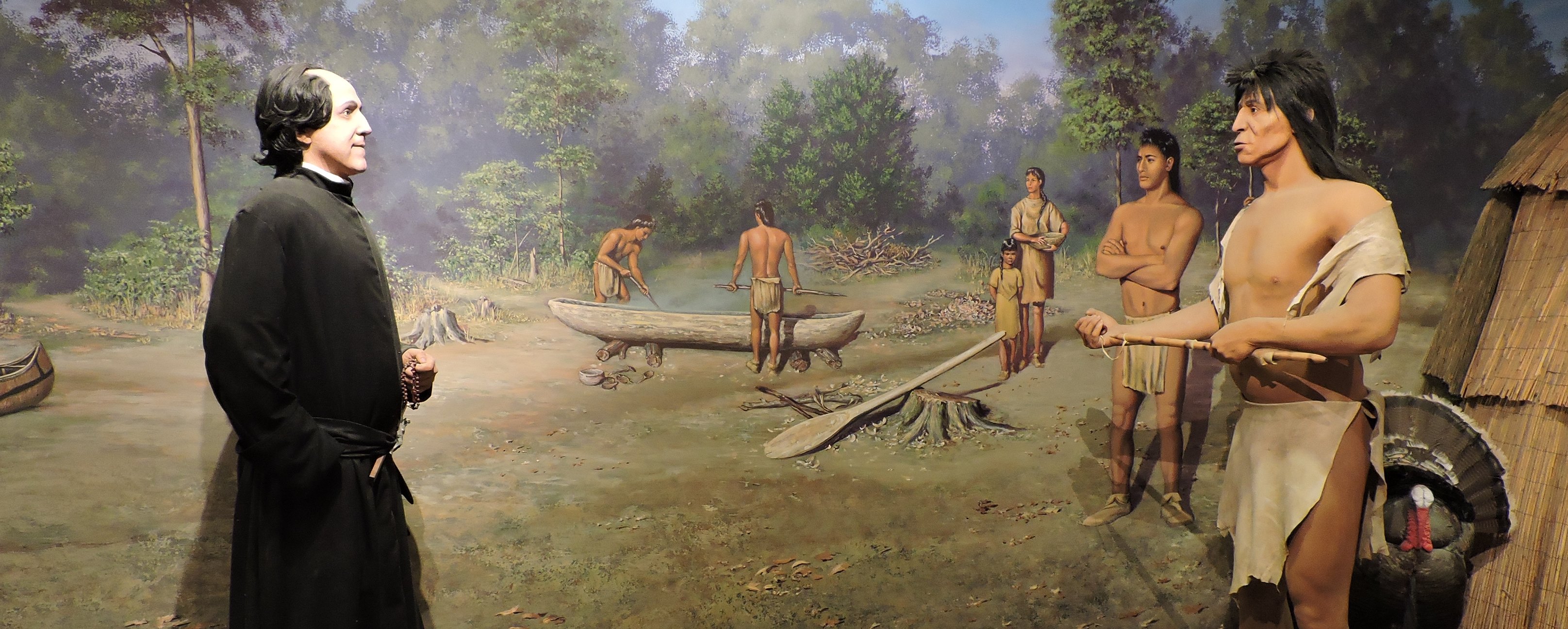
After spending an anxious night among the Michigamea the French were escorted by their hosts to an Arkansas village located only a short distance away from the mouth of the Arkansas River. It was at that village that Jolliet and Marquette knew they had to make a decision: Should they continue to the Gulf which they had been led to believe was only ten days travel from the village (it was actually 700 miles away)? If so, would they encounter hostile tribes? Would they risk capture and possible death at the hands of the Spanish who were reportedly in the region? If they continued to the Gulf would they risk losing all the important information they had collected during their journey? Or since they had fulfilled nearly all of their mission’s objectives, should they return to Canada? They agreed to return north. Leaving the Arkansas village on July 17, the group paddled up the Mississippi. At Grafton, Illinois they steered their canoes up the Illinois River, becoming the first known people of European descent to travel that stream. Both Jolliet and Marquette were impressed by what they saw. Prairies, wildlife, and land ready for the plow that did not require hours of labor to clear.
Near Utica the French party stopped at a village of Kaskaskia Indians, another subtribe of the Illinois alliance. There Marquette spoke with the village chiefs and elders who obliged the missionary to return to instruct his people in the Catholic faith. In seven years the village would grow from 74 cabins, or about 1,450 inhabitants as reported by Marquette, to more than 400 cabins, or a population of over 7,000. Trade, military alliance, and the religious conversion of the Illinois at Kaskaskia are what brought the French to present-day Illinois.
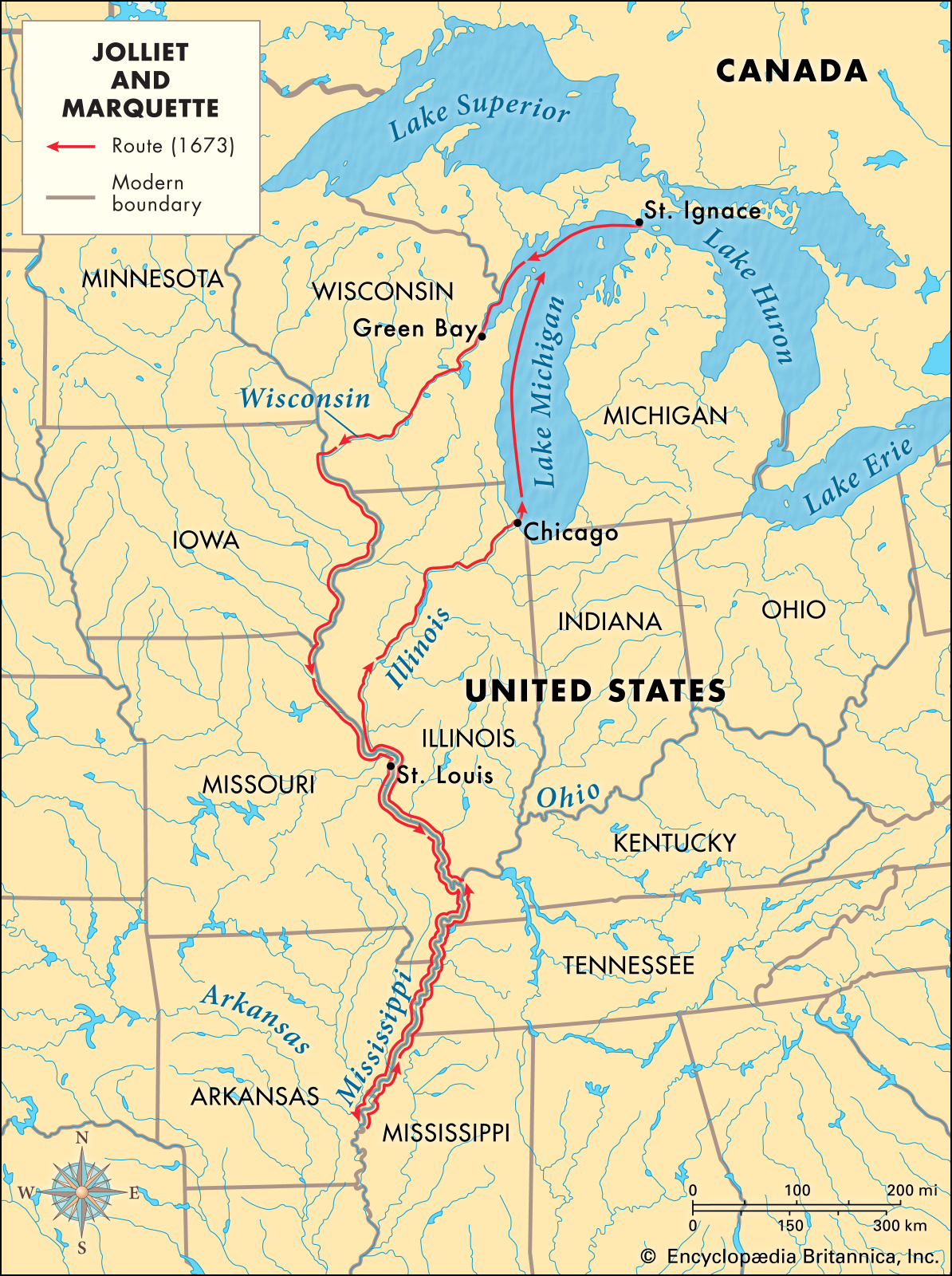
The explorers left Kaskaskia under an escort of Kaskaskia guides. Their route took them up the Illinois to the Des Plaines River and up the Des Plaines to the Chicago Portage. Crossing the muddy portage they launched their canoes onto the Chicago River and paddled to Lake Michigan. Heading north they arrived at the St. Francis Xavier mission at De Pere, Wisconsin. It is at this time that Marquette probably gave Jolliet a copy of his relation, his report, to deliver to Jesuit authorities in Quebec. Jolliet and the crew continued north to his trading post at Sault Ste. Marie, where they wintered. After ice-out, Jolliet and three others paddled to Quebec to report their discoveries to Canadian authorities. Unfortunately their canoe capsized in the rapids near Montreal. Everything in the canoe was lost, two men, an Indian boy, curios and specimens collected during the expedition, and Marquette’s report (Marquette kept a copy that arrived in Quebec in 1675). Only Jolliet survived the wreck. On August 1, 1674, Jolliet met with now Jesuit Superior of Canada, Claude Dablon, and gave the Jesuit his verbal account of the expedition.
Marquette remained at the St. Francis mission. He suffered from an internal malady that would ultimately take his life. By October 1674 his condition had abated and he felt well enough to return to Kaskaskia. On the 25th he and two companions Jacques Largillier and Pierre Porteret set out for the Illinois village. During the journey Marquette’s condition returned with a vengeance. Inclement weather, frozen waterways, and an ailment that turned into “a bloody flux,” as Marquette described it, made the long, difficult trek to Kaskaskia even more grueling.
The party arrived at Kaskaskia on April 9, on the Thursday before Easter. But even though the missionary was suffering, he still found the strength to visit the Illinois in their cabins and meet with the chief and elders in council. He also celebrated Mass on Easter Sunday. Marquette and his companions soon left Kaskaskia for his St. Ignace mission at Michilimackinac where he hoped to get some well-deserved rest and perhaps some basic medical attention. He never made it, he died while en route and was buried presumably somewhere along the Marquette River in Michigan.
The Jolliet-Marquette expedition of 1673 was important for many reasons. It was the first time non-native people explored the central portions of the Mississippi River. It was the first to determine the courses of rivers that ran through the interior of the North American continent. It determined that the Mississippi empties into the Gulf of Mexico and that the Ohio River was not the Mississippi. It was the first attempt to understand the geography of Mississippi Valley. It also served as the impetus behind later French occupation of the Illinois Country. The 1673 expedition was as important in its day as the Lewis and Clark expedition was to the young United States and the Apollo 11’s lunar landing was to 20th century Americans.

